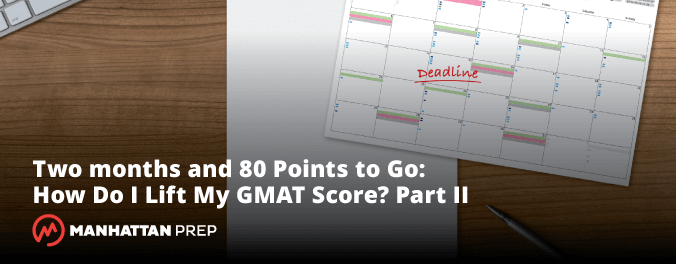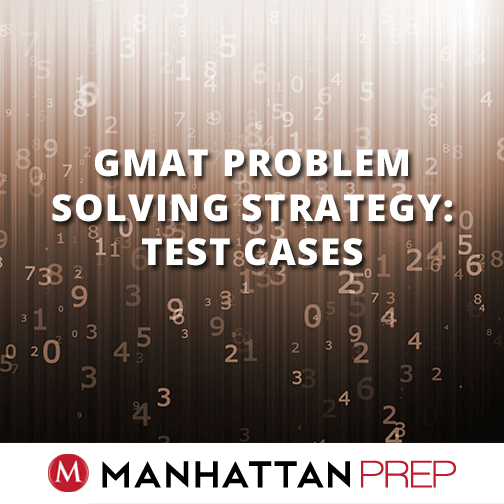Three things to love about GMAT Roman numeral problems
 I. Roman numeral Quant problems aren’t a whole lot of fun.
I. Roman numeral Quant problems aren’t a whole lot of fun.
II. A lot of my students choose to skip them entirely, which is much smarter than wasting five minutes wondering what to do!
III. However, it’s possible to turn this rare and tricky problem type into an opportunity.
Read on, and learn why many GMAT high-scorers love Roman numeral problems. Read more
GMAT Story Problems: Draw It Out
 Whenever I see a story problem, I immediately make myself think, “How would I solve this in the real world?” I don’t want to get sucked into doing a bunch of annoying textbook math. In the real world, we lay things out on paper very differently than when we’re in “I’m taking a math test” mode.
Whenever I see a story problem, I immediately make myself think, “How would I solve this in the real world?” I don’t want to get sucked into doing a bunch of annoying textbook math. In the real world, we lay things out on paper very differently than when we’re in “I’m taking a math test” mode.
Want to see what I mean? Try this GMATPrep® problem from the free exams and then we’ll talk! Read more
Here’s how to use the holidays for GMAT prep (Part 2)
 Last time, we talked about how to use holiday downtime to get ready for round 2 GMAT admissions. This time, we’re going to talk about what to do if you aren’t applying for round 2 this year.
Last time, we talked about how to use holiday downtime to get ready for round 2 GMAT admissions. This time, we’re going to talk about what to do if you aren’t applying for round 2 this year.
We have two broad scenarios to talk about: Read more
Here’s how to use the holidays for GMAT prep (Part 1)
 The holidays are fast approaching and all of my students are asking me how best to use their extra downtime over the next few weeks. I have some different recommendations, depending upon your circumstances.
The holidays are fast approaching and all of my students are asking me how best to use their extra downtime over the next few weeks. I have some different recommendations, depending upon your circumstances.
In this installment, we’ll talk about what to do if you’re aiming for the second round (in other words, your applications are due in January 2016—soon!). In the next installment, we’ll talk about what to do if this circumstance does not apply to you. Read more
Here’s why you might be missing GMAT Data Sufficiency problems – Part 2

Did you know that you can attend the first session of any of our online or in-person GMAT courses absolutely free? We’re not kidding! Check out our upcoming courses here.
In our previous article, we divided the logical errors that test-takers make on Data Sufficiency questions into two types:
Type 1: You thought that something was sufficient, but it was actually insufficient.
Type 2: You thought that something was insufficient, but it was actually sufficient.
We already covered the most common reasons for Type 1 errors to occur and a few good ways to avoid them; now, let’s cover Type 2 errors. Read more
Two months and 80 points to go: How do I raise my GMAT score? (Part 2)
 In the first part of this series, we talked about how to analyze your strengths and weaknesses and in which categories of “low hanging fruit” to concentrate your studies.
In the first part of this series, we talked about how to analyze your strengths and weaknesses and in which categories of “low hanging fruit” to concentrate your studies.
We left off talking about timing; let’s talk about how to make better decisions as you take the test. Read more
Manhattan Prep’s GMAT® study app is now available!
 I am very excited to announce that our new GMAT® study app is available on both iOS and Android!
I am very excited to announce that our new GMAT® study app is available on both iOS and Android!
Download now!
iOS
Android
Two months and 80 points to go: How do I raise my GMAT score? (Part 1)
 Most second-round deadlines are in early January, so around now, a lot of people are asking me how to eke out the last 30 to 80 points they need to reach their goal.
Most second-round deadlines are in early January, so around now, a lot of people are asking me how to eke out the last 30 to 80 points they need to reach their goal.
Let’s talk about what to do to try to lift your score that last bit in the final 2 months of your study.
Is this article for me?
The GMAT’s not a math test – it’s a foreign language test!
 A student of mine once emailed me after he took the GMAT. Instead of telling me his score, he wrote, “let’s just say that 4 times my score is a multiple of 88, and 5 times my score is a multiple of 35.”
A student of mine once emailed me after he took the GMAT. Instead of telling me his score, he wrote, “let’s just say that 4 times my score is a multiple of 88, and 5 times my score is a multiple of 35.”
Can you tell what he got? If not…you may need to work on your GMAT translation skills! Read more
GMAT Problem Solving Strategy: Test Cases
 If you’re going to do a great job on the GMAT, then you’ve got to know how to Test Cases. This strategy will help you on countless quant problems.
If you’re going to do a great job on the GMAT, then you’ve got to know how to Test Cases. This strategy will help you on countless quant problems.
This technique is especially useful for Data Sufficiency problems, but you can also use it on some Problem Solving problems, like the GMATPrep® problem below. Give yourself about 2 minutes. Go!
* “For which of the following functions f is f(x) = f(1 – x) for all x?
| (A) | f(x) = 1 – x |
| (B) | f(x) = 1 – x2 |
| (C) | f(x) = x2 – (1 – x)2 |
| (D) | f(x) = x2(1 – x)2 |
| (E) | f(x) = x / (1 – x)” |
Testing Cases is mostly what it sounds like: you will test various possible scenarios in order to narrow down the answer choices until you get to the one right answer. What’s the common characteristic that signals you can use this technique on problem solving?
The most common language will be something like “Which of the following must be true?” (or “could be true”).
The above problem doesn’t have that language, but it does have a variation: you need to find the answer choice for which the given equation is true “for all x,” which is the equivalent of asking for which answer choice the given equation is always, or must be, true.
Read more